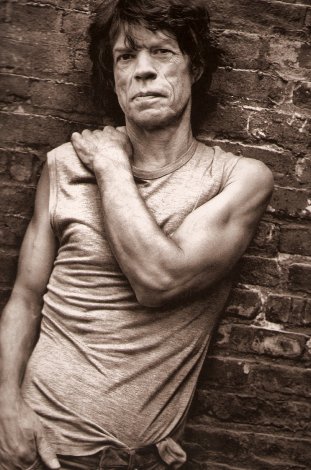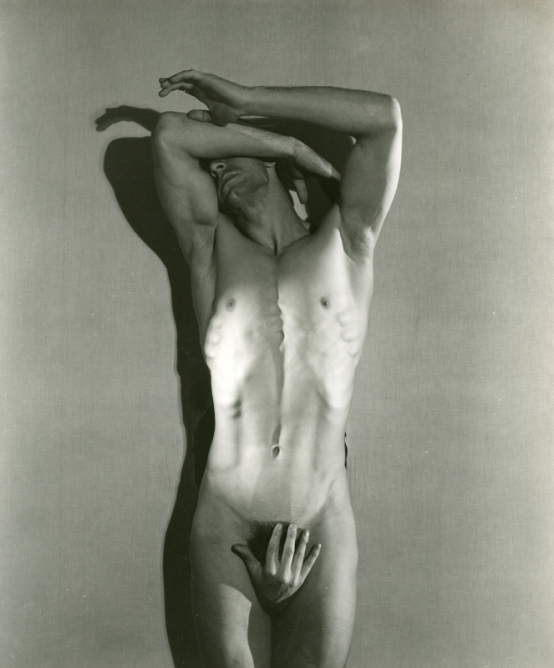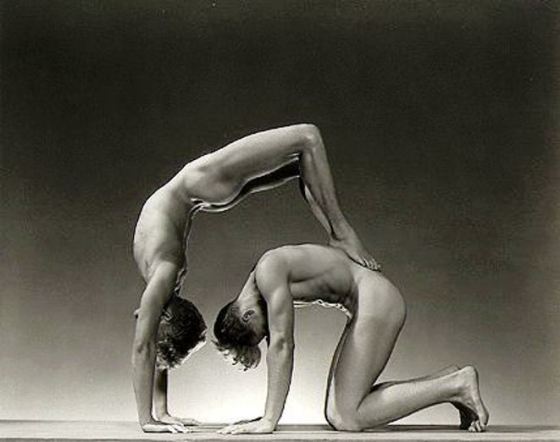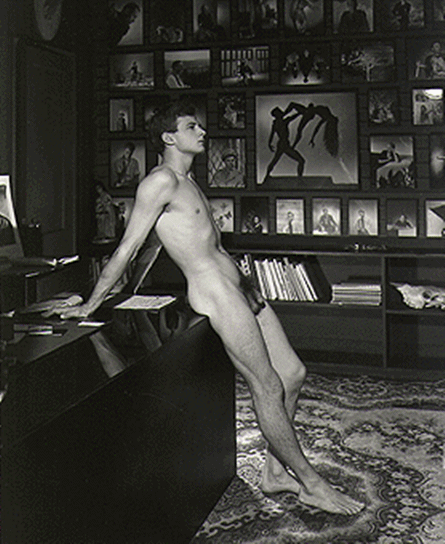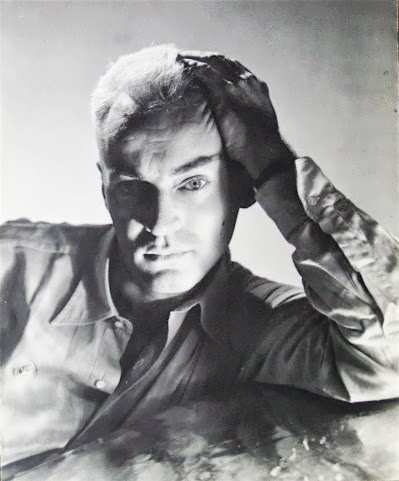“Nijinsky has never been so remarkable as in his latest role. No more jumps – nothing but half-conscious animal gestures and poses. He lies down, leans on his elbow, walks with bent knees, draws himself up, advancing and retreating, some-times slowly, sometimes with jerky angular movements. His eyes flicker, he stretches his arms, he opens his hands out flat, the fingers together, and as he turns away his head he continues to express his desire with a deliberate awkwardness that seems natural. Form and meaning are indissolubly wedded in his body, which is totally expressive of the mind within… His beauty is that of antique frescoes and sculptures: he is the ideal model, whom one longs to draw and sculpt.”
Auguste Rodin
 Programme illustration by Léon Bakst for the ballet
Programme illustration by Léon Bakst for the ballet
The ballet L’Après-midi d’un faune (The Afternoon of a Faun)was choreographed by Vaslav Nijinsky for the Ballets Russes and first performed in the Théâtre du Châtelet in Paris on 29 May 1912. On the opening night the ballet was met with a mixture of applause and booing, and again it was repeated. Now the audience applauded, and Auguste Rodin in the audience stood up to cheer.
Nijinsky danced the main part himself. As its score it used the Prélude à l’après-midi d’un faune by Claude Debussy. Both the music and the ballet were inspired by the poem L’Après-midi d’un faune by Stéphane Mallarmé. The painter Odilon Redon, friend of Mallarmé, suggested how much the poet would have approved, “more than anyone, he would have appreciated this wonderful evocation of his thoughts.”



The costumes and sets were designed by the painter Léon Bakst. L’Après-midi d’un Faune is considered one of the first modern ballets and proved to be as controversial as Nijinsky’s Jeux (1913) and Le Sacre du printemps (1913).
The style of the ballet, in which a young faun meets several nymphs, flirts with them and chases them, was deliberately archaic. In the original scenography designed by Léon Bakst, the dancers were presented as part of a large tableau, a staging reminiscent of an ancient Greek vase painting. They often moved across the stage in profile as if on a bas relief. The ballet was presented in bare feet and rejected classical formalism. The work had an overtly erotic subtext beneath its façade of Greek antiquity, ending with a scene of graphic sexual desire.
The ballet was developed as a possible new production for the Ballets Russes founded by Sergei Diaghilev. Most of the dances performed by the company were choreographed by Michel Fokine, who had worked as a choreographer with the Imperial Russian Ballet, from which all the different specialists for the new ballet company had come. Initially the Ballet Russes took advantage of the 3 months summer break, when the Imperial ballet closed and its staff were free to do other things, to stage ballet and opera in Paris. Diaghilev was looking around for an alternative to the style which Fokine customarily delivered and decided to allow his senior male dancer, Vaslav Nijinsky, to try his hand at choreography.
 Menelaus intending to strike Helen is struck by her beauty instead. Louvre museum, Campana collection acquired 1861
Menelaus intending to strike Helen is struck by her beauty instead. Louvre museum, Campana collection acquired 1861
The original idea was developed by Diaghilev, Nijinsky and Bakst and was inspired by the artwork on ancient Greek vases and Egyptian and Assyrian frescoes which they viewed in the Louvre museum. Bakst had already worked with Vsevolod Meyerhold, an innovative theatre producer and director who had introduced concepts like two-dimensionality, stylized postures, a narrow stage, pauses and pacing to emphasise significant moments, into his productions. Ninjinsky’s aim was to reproduce the stylised look of the ancient artworks on the stage. In his portrayal of the faun, Nijinsky managed to reproduce exactly the figure of a satyr shown on Greek vases in the Louvre. Such concepts appear transferred to ballet.
Jean Cocteau helped to explain the Mallarmé poem (Nijinsky spoke little French) and with developing a scenario for the ballet. The music by Debussy already existed in a fully orchestrated form. After the summer season in Paris, Nijinsky returned to St Petersburg for the new Russian season and there started to work on the choreography with the help of his sister, Bronislava Nijinska, who was herself a senior dancer and who later choreographed her own ballets for Ballets Russes. Nijinsky was much excited about the project.
 Cartoon by Daniel de Losques published in Le Figaro, 30 May 1912
Cartoon by Daniel de Losques published in Le Figaro, 30 May 1912

 Nijinsky as the Faun, illustrations by George Barbier, 1913
Nijinsky as the Faun, illustrations by George Barbier, 1913


 Baron de Meyer published a book of photographs of the ballet
Baron de Meyer published a book of photographs of the ballet

 The nymph dance in the dream sequence of the film Sunnyside (Charlie Chaplin, 1919) has been recognized as being a tribute to the ballet
The nymph dance in the dream sequence of the film Sunnyside (Charlie Chaplin, 1919) has been recognized as being a tribute to the ballet
 A pastiche of the ballet (choreographed by the then leader of the Royal Ballet, Wayne Eagling, a friend of Mercury who had helped him before with the choreography of the Bohemian Rhapsody) forms part of the music video for Queen’s single I Want to Break Free (David Mallet, 1984). Freddie Mercury dances the role of the faun, with dancers from the Royal Ballet also performing, including Jeremy Sheffield. Mercury shaved his trademark moustache to portray Vaslav Nijinsky as a faun in the ballet L’après-midi d’un faune.
A pastiche of the ballet (choreographed by the then leader of the Royal Ballet, Wayne Eagling, a friend of Mercury who had helped him before with the choreography of the Bohemian Rhapsody) forms part of the music video for Queen’s single I Want to Break Free (David Mallet, 1984). Freddie Mercury dances the role of the faun, with dancers from the Royal Ballet also performing, including Jeremy Sheffield. Mercury shaved his trademark moustache to portray Vaslav Nijinsky as a faun in the ballet L’après-midi d’un faune.
Queen’s video can be seen on The Genealogy of Style‘s Facebook Page: https://www.facebook.com/pages/The-Genealogy-of-Style/597542157001228
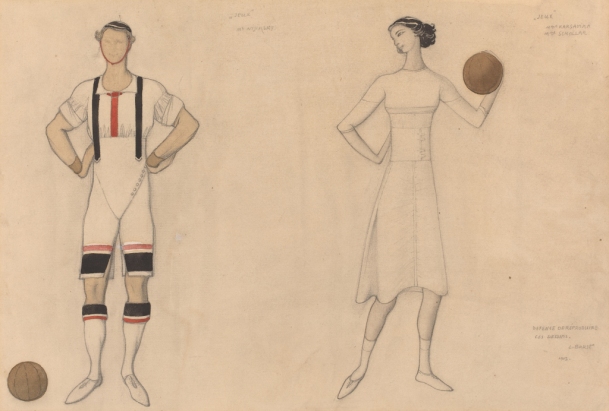 A minimalist, modern rendering by Léon Bakst for Costume Study for Jeux. Watercolor, graphite and black chalk on laid paper. Credit: National Gallery of Art, Washington D.C.
A minimalist, modern rendering by Léon Bakst for Costume Study for Jeux. Watercolor, graphite and black chalk on laid paper. Credit: National Gallery of Art, Washington D.C. Tamara Karsavina, Vaslav Nijinsky and Ludmilla Schollar in Jeux
Tamara Karsavina, Vaslav Nijinsky and Ludmilla Schollar in Jeux


























































